
As you add more water, the color will become more vibrant, brighter and more transparent. The color that is diluted the most will be the most transparent of all. The whiteness of the paper can be seen most clearly through the lightest color tone. As the color tone becomes denser and darker it becomes less transparent.

You can intentionally pick out light areas in your illustrations by leaving certain sections blank. These white unpainted sections act as points of light or light reflectors and make what you have painted appear more authentic and lifelike.

You can also use specifically targeted white patches to separate certain areas so that parts of the illustration are more clearly defined.

In watercolor painting it is difficult to add white points to applied paint, as the colors are sometimes still soluble on the paper even when dry. Equally, it is not usually possible to coax out a clear white from under the painted color. So, it is particularly important to think about the white areas beforehand and leave them blank.
In certain cases, minor highlights such as fine points of light in the eyes can be added later using a white Uni-Ball Signo pen.